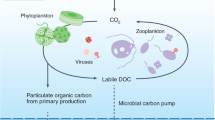Abstract
In deep ocean waters the concentrations of free amino acids are very close to blank levels, while surface waters contain only very low quantities1,2. However, the concentration of ‘combined’ amino acids (whoch occur at all ocean depths in significant quantities) is roughly 10 times that of free amino acids1,2. These combined amino acids are bound in some sort of polymeric material and are released only on hydrolysis in strong acid. The combined amino acid material apparently has a substantial D-aspartic acid content; the D/L aspartic acid ratio in the combined amino acid fraction, isolated from water from the Sargasso Sea, is ∼0.4 at all depths2. It has been suggested that combined amino acids were not actually part of the dissolved organic material in the oceans but were components of bacteria that passed through the filter used in the initial seawater-processing step2,3. Although in most organisms only the L-enantiomers of the amino acids are present, becateria contain several D-amino acids in then cell-wall proteins4. To verify the bacterial explanation we have carried out investigations into the enantiomeric composition of amino acids, besides aspartic acid, in the combined fraction. We measured the alanine enan-tiomeric ratio in seawater samples from three stations in the Pacific Ocean. Alanine was chosen because it is one of the more abundant components of the combined amino acid fraction in the oceans1,2, and because D-alanine is a major component of bacterial cell-wall proteins4.
This is a preview of subscription content, access via your institution
Access options
Subscribe to this journal
Receive 51 print issues and online access
$199.00 per year
only $3.90 per issue
Buy this article
- Purchase on Springer Link
- Instant access to full article PDF
Prices may be subject to local taxes which are calculated during checkout
Similar content being viewed by others
References
Lee, C. & Bada, J. L. Earth planet. Sci. Lett. 26, 61 (1975).
Lee, C. & Bada, J. L. Limnol. Oceanogr. 22, 502 (1977).
Bada, J. L. & Lee, C. Mar. Chem. 5, 523 (1977).
Meister, A. Biochemistry of the Amino Acids, 2nd edn, 113–115 (Academic, New York, 1974).
Hoopes, E. A., Peltzer, E. T. & Bada, J. L. J. chromatogr. Sci. 16, 556 (1978).
Schroeder, R. A. & Bada, J. L. Earth Sci. Rev. 12, 347 (1976).
Bada, J. L. Adv. Chem. Ser. No. 106, 309 (1971).
Craig, H. J. geophys. Rev. 76, 5078 (1971).
Bada, J. L., Shou, M.-Y., Man, G. & Schroeder, R. A. Earth planet. Sci. Lett. 41, 67 (1978).
Shou, M.-Y. thesis, Univ. California (1979).
Author information
Authors and Affiliations
Rights and permissions
About this article
Cite this article
Bada, J., Hoopes, E. Alanine enantiomeric ratio in the combined amino acid fraction in seawater. Nature 282, 822–823 (1979). https://doi.org/10.1038/282822a0
Received:
Accepted:
Issue Date:
DOI: https://doi.org/10.1038/282822a0
This article is cited by
-
The Role of Submarine Hydrothermal Systems in the Synthesis of Amino Acids
Origins of Life and Evolution of Biospheres (2009)
-
Prebiotic synthesis in atmospheres containing CH4, CO, and CO2
Journal of Molecular Evolution (1983)
-
Carotenoid transformations in coastal marine waters
Nature (1982)
Comments
By submitting a comment you agree to abide by our Terms and Community Guidelines. If you find something abusive or that does not comply with our terms or guidelines please flag it as inappropriate.



